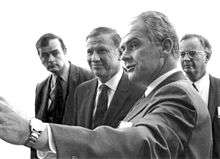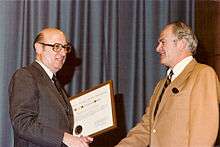Lawrence Edwards
Lawrence (Larry) K. Edwards (July 10, 1919 – April 4, 2009)[1] was an American innovator in aerospace and ground transportation. Early in his career, he pioneered technologies for U.S. space and missile defense programs. He went on to invent and promote high-speed Gravity-Vacuum Transit[2] and monobeam rail transit. He obtained a total of 14 patents in those areas.
Early life and education
Edwards, the son of a physics professor, was born in Delaware, Ohio, United States. Raised in Oxford, Ohio, he graduated Phi Beta Kappa from Miami University where he studied geology, math and physics.
Accomplishments in aerospace
Edwards played a role in the engineering of four of the nation's major aerospace programs:
- Talos,[3] a long-range surface-to-air missile that served as the U.S. Navy's primary anti-aircraft missile for 20 years. Talos was history's first supersonic missile with ramjet propulsion, making it far more fuel-efficient than rockets. Edwards was project engineer for the program at McDonnell Aircraft Corp., which later became McDonnell Douglas.
- Polaris,[4] the first in a succession of submarine-based Fleet Ballistic Missiles. Edwards managed its preliminary design at Lockheed Missile Systems Division, (now Lockheed Martin) and continued as assistant director for systems engineering during the missile's early development.
- Lockheed Agena,[5] which became America's most-used space vehicle. Agena's first use was to support cameras and recoverable film of Corona, history's first spy satellite, providing intelligence for four successive Presidents. Additional uses included the first successful cameras to the moon, Venus and Mars and propelling Gemini astronauts to world-record speed and altitude. Edwards was instrumental in debugging the troubled A and B versions of Agena and then initiated the Agena D.
- Space Shuttle: Edwards' aerospace achievements paved the way for his appointment as Director of Shuttle Engineering at NASA headquarters. He later became Chief of Advanced Space Transportation. In addition, he served as NASA's primary DOD technical interface for the Strategic Defense Initiative and on NASA's Inventions and Contributions Board.
Accomplishments in ground transportation

Edwards founded three firms dedicated to his innovations in ground transportation, Tube Transit Corp., Transit Innovations and Futrex Inc. His pursuits in this field include:
- Inventing and promoting Gravity-Vacuum Transit,[6] a technology that combines gravity and atmospheric pressure to speed trains through evacuated underground tubes at 250 to 400 mph. Advocated for the New York City region as well as a Boston to Washington line by the Regional Plan Association, — the invention was praised by Secretary of Transportation John Volpe as well as editorials in The New York Times and professional and scientific journals.[7] It was the lead article in the August 1965 edition of Scientific American.
- Inventing and promoting the Project 21 monobeam, later System 21, the world's only aerial rail system suitable for networks above city streets.[8] Whereas a classical monorail requires a pair of beams for two-way traffic and its switching limitations hinder its ability to run on networks, the monobeam carries opposite trains alongside a single slender beam; its footprint is smaller, and its breakthrough switching technology enables it to form networks.
System 21 was praised by two Secretaries of Transportation and Vice President Al Gore[9] as well as the Regional Plan Association in two federally supported books. In March 1989, the Federal Register noted, "This project has high technical merit representing an innovative technology which has a strong possibility of allowing for future reductions in the nation's energy consumption."[10] - Inventing and publicizing Project 32 Slalom, a compact three-wheel vehicle designed for students and suburban commuters. Edwards' patented suspension lets the vehicle lean into turns like a bicycle and, in very sharp turns, dramatically reduces the lateral forces experienced in four-wheel vehicles.[11]
Honors and awards

Edwards was twice nominated by Lockheed executives for the National Medal of Technology, the highest U.S. honor for technological achievement. In 1980, NASA awarded him a team leadership award for his role in the Skylab Reentry Program. His inventions have been publicized in dozens of national newspapers, magazines and books. On three occasions, they were illustrated as "Patent of the Week" in the New York Times.
Grants
Edwards received six federal grants for his work in Gravity-Vacuum Transit and System 21.[12] Additionally, $1.25 million in Commerce Department funds supported the construction of a functional scale model of System 21 in Charleston, South Carolina. It was unveiled in 1996.
Professional affiliations
Edwards was a member of the Society of Automotive Engineers and the Cosmos Club of Washington, an organization for those distinguished in science, literature and the arts. He was also an associate fellow of the American Institute of Aeronautics and Astronautics and a member of the American Society of Mechanical Engineers, American Society of Civil Engineers and the Transportation Research Board of the National Academy of Sciences.
References
- ↑ http://www.miamialum.org/s/916/internalSub.aspx?sid=916&gid=1&pgid=1988&cid=4717&ecid=4717&crid=0&calpgid=1978&calcid=4713
- ↑ Gravity-Vacuum Transit
- ↑ Aviation Week June 2, 1958: Talos Has Conventional, Nuclear Punch
- ↑ U. S. Navy Department book, circa 2000 Facts: Polaris - Poseidon - Trident
- ↑ Space Chronicle of JBIS, August 2006: Genesis of Agena D, America's Most-Used Space Vehicle
- ↑ Science, October 15, 1965, Volume 150, Number 3654, Barriers to Innovation
- ↑ The New York Times, Monday, August 30, 1965, High-Speed Rail Transit
- ↑ University of Washington
- ↑ Passenger Transport, May 4, 1998, Page 7, Vice President Gore Visits FUTREX Site in Charleston
- ↑ Federal Register, Vol. 54. No. 55, Thursday, March 23, 1989, Notices
- ↑ Robert Q. Riley Enterprises
- ↑ Railway Age, January 1999, Page 29, FUTREX Monobeam Receives Federal Grant